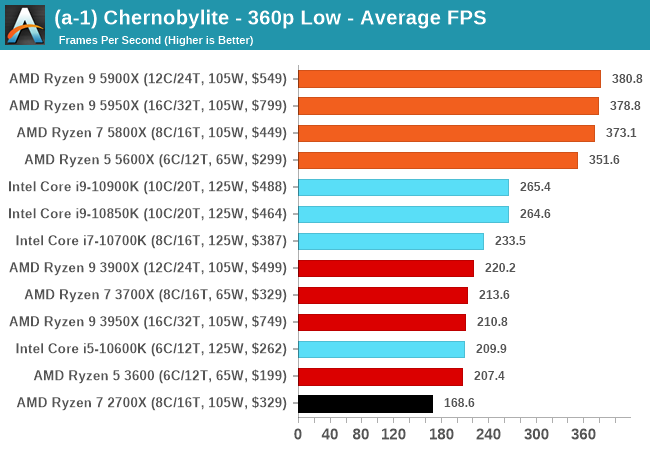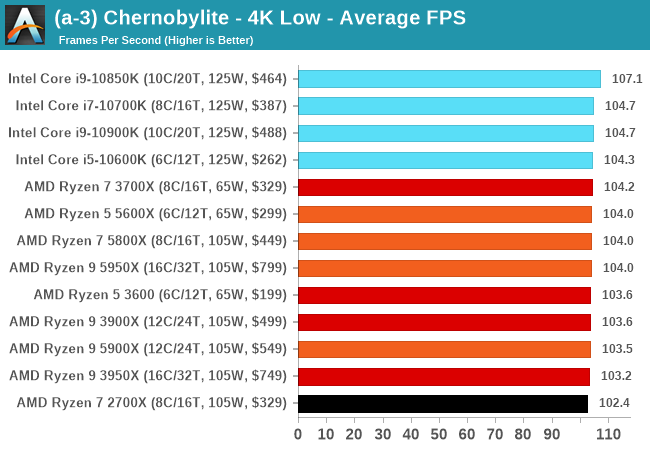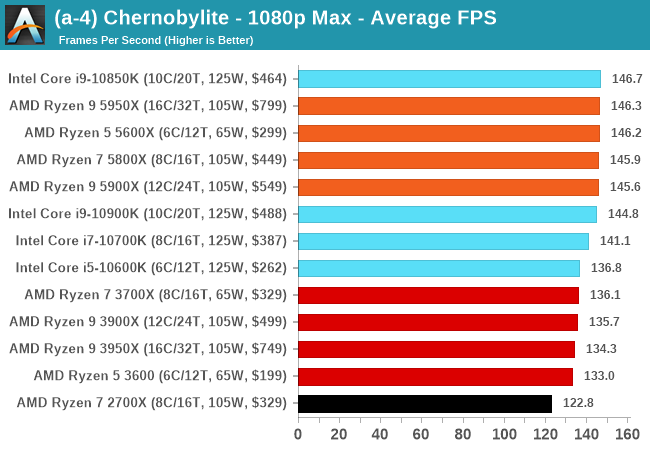AMD Zen 3 Ryzen Deep Dive Review: 5950X, 5900X, 5800X and 5600X Tested
by Dr. Ian Cutress on November 5, 2020 9:01 AM ESTGaming Tests: Chernobylite
Despite the advent of recent TV shows like Chernobyl, recreating the situation revolving around the 1986 Chernobyl nuclear disaster, the concept of nuclear fallout and the town of Pripyat have been popular settings for a number of games – mostly first person shooters. Chernobylite is an indie title that plays on a science-fiction survival horror experience and uses a 3D-scanned recreation of the real Chernobyl Exclusion Zone. It involves challenging combat, a mix of free exploration with crafting and non-linear story telling. While still in early access, it is already picking up plenty of awards.
I picked up Chernobylite while still in early access, and was impressed by its in-game benchmark, showcasing complex building structure with plenty of trees and structures where aliasing becomes important. The in-game benchmark is an on-rails experience through the scenery, covering both indoor and outdoor scenes – it ends up being very CPU limited in the way it is designed. We have taken an offline version of Chernobylite to use in our tests, and we are testing the following settings combinations:
- 360p Low, 1440p Low, 4K Low, 1080p Max
We do as many runs within 10 minutes per resolution/setting combination, and then take averages.
| AnandTech | Low Resolution Low Quality |
Medium Resolution Low Quality |
High Resolution Low Quality |
Medium Resolution Max Quality |
| Average FPS |  |
 |
 |
 |
All of our benchmark results can also be found in our benchmark engine, Bench.












339 Comments
View All Comments
GeoffreyA - Thursday, November 5, 2020 - link
Battling to load the article for hours, but looks like it's finally working. On page 3 now.GeoffreyA - Friday, November 6, 2020 - link
Thanks for the excellent analysis, AT. Zen 3 has delivered, even more than expected. Brings back memories of the Athlon 64 FX-51 at the top of charts and later the Core 2 Duo, which left K8 dead on the floor. I am impressed by the IPC's having gone up so much but power remaining roughly the same. And, besides the widening, surprisingly conservative, there are a lot of "intelligent" techniques bringing about improvement (reminiscent of the Pentium M in a way). All in all, outstanding work from AMD. The engineers deserve a round of applause.GeoffreyA - Saturday, November 7, 2020 - link
Ian, not sure if I missed it, but what version of Windows does the test suite use? The CPU overload article says 1909. According to Techpowerup, there have been some scheduler changes since 1903 and the difference in performance was a few per cent. for Zen 3. Thanks.https://www.techpowerup.com/review/amd-ryzen-9-590...
mjcutri - Thursday, November 5, 2020 - link
Was pleasantly surprised that I was able to pick up a 5600x from newegg this morning. It'll be a nice upgrade from my i7-3920 that I've been running for 8 years!lmcd - Thursday, November 5, 2020 - link
The thing that's so funny to me is how well Sandy Bridge E has held up. Nearly every board supports PCIe 3.0 and SATA III, quad-channel memory means it's not memory bound, and it clocks up quite well.Obviously performance per watt sucks and it doesn't game as well anymore, but the feature set is way more usable than I'd ever have expected 8 years later.
Spunjji - Sunday, November 8, 2020 - link
It was a really solid platform. Throw in an SSD on PCIe and you wouldn't miss an awful lot from a more modern system, but it looks like that point has finally been reached... 8 years later!lmcd - Monday, November 9, 2020 - link
I wish both Intel and AMD would bring prosumer platforms back. While obviously SLI and XF are dead, PCIe lanes are nice to have and I/O futureproofing is actually impossible anymore.Qasar - Tuesday, November 10, 2020 - link
id just like to see more PCIe lanes. maybe 8-16 more ?Vitor - Thursday, November 5, 2020 - link
The craziest thing is that AMD has a very easy upgrade path with 5nm being avaible.CrystalCowboy - Thursday, November 5, 2020 - link
5 nm, DDR5, PCIe 5, USB4. These are all obvious future developments. They will do a new socket for that; will be interesting to see what they do with that.